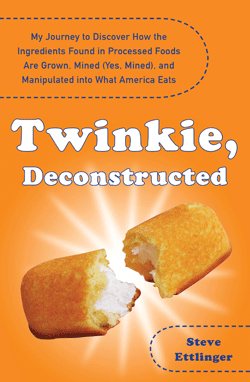Zingers, Devil Dogs, Sno Balls, or classic Twinkies? Ever since Hostess Brands announced a few weeks ago that it’s going out of business, everyone seems to be declaring their snack-cake allegiances. Since it’s uncertain how much longer the everlasting creme-filled yellow cakes will be available, Last Chance Foods dubbed it a worthy topic and, this week, strayed from the produce section to check out the snack aisle.
Steve Ettlinger, author of Twinkie, Deconstructed, said he has unexpectedly been on the receiving end of countless junk-food confessions. “Some [people] started out by saying, ‘You know, I was really more of a Ding Dong man,’” Ettlinger explained. “I’ve had so many confession from journalists, from people on the street, from friends of whether they eat them or not. Everybody relates to them somehow. These little cakes have a powerful hold on our national psyche.”
Ettlinger, who said his tastes tend to run more toward Sno Balls, wrote the book with the mission of tracking down the origins of ingredients in processed foods. He wanted to see if they exhibited terroir, the concept that the growing environment of an ingredient affects its taste.
Twinkies provide a convenient organizing principle to his investigations. 
“I wondered, perhaps perversely, is there a terroir for polysorbate-60 or red number 40?” Ettlinger explained. “Is there, like, the best red number 40 source?” The answer, it turns out, is yes. He explained that the tree in Malaysia from which the oil in polysorbate is harvested, as well as the corn and other elements that go into its formulation, do have bearing on the final product.
Back to Twinkies, though. Ettlinger admitted that he’s not a huge fan of the snack, despite having a book based on it. But he has made his own Twinkies from organic cake mix and heavy cream. (His recipe is below.) Those, Ettlinger said, disappeared rapidly.
He started with a Twinkie mold. “You can make a Twinkie mold yourself, by wrapping foil around... a spice jar, or maybe an aspirin jar or something like that,” Ettlinger said. “But you definitely want a mold, otherwise they’re not Twinkies, it’s just cake.”
The heavy cream that he grabbed at the grocery store also included polysorbate-80, which lent an unexpected touch of authenticity to his homemade Twinkie. Before applying “two-and-a-half to three minutes of wildly manic elbow grease” to the whipping cream, he added confectioners sugar and vanilla.
As for the possible disappearance of pre-packaged Hostess Brand Twinkies, Ettlinger is certain that it doesn’t signal a future where store shelves are stocked only with kale chips. “We always need snacks, and we should have them,” Ettlinger said. He added with a chuckle that he’s also been known to sneak in an eclair or two on occasion.
Steve Ettlinger’s Homemade Twinkies
I like to keep it simple, as befits a simple snack cake — to use the fewest possible artificial ingredients and generate the most refreshing snack. Prices are from my local grocery store. —SE 
Ingredients:
- Dr. Oetker Organics Vanilla cake mix ($4.59) or King Arthur Golden Vanilla Cake mix ($8.99)
- heavy cream (1 pint)
- confectioner's sugar
- vanilla flavoring
- lots of elbow grease, if beating by hand (the best way)
Equipment:
large mixing bowl
- sturdy whisk or electric beater
- sheet cake pan or Twinkie mold pan (Norpro 3964 Cream Canoe Pan or homemade Twinkie molds)
1. Cake: Make cake according to directions on package; baking time might be shorter in Twinkie molds or large sheet pans! (Fill molds only part way or else they will over flow).
2. "Creamy filling" substitute, which in this case is actually a CREAM filling: Depending on your experience, do what you like with the whipped cream. For beginners, take about half a pint of cream, about a tablespoon of vanilla, possibly a pinch of salt, and about a half cup of sugar (all to taste). Beat VIGOROUSLY by hand for 2.5 to 3 minutes–really whip it up (you are incorporating air; sing "BEAT IT!" at the top of your lungs if need be, and watch out for splatter which must be licked up immediately), until cream suddenly stiffens and peaks form when you remove the whisk. Lick whisk repeatedly to taste (and add more sugar and/or vanilla as needed) and to satisfy increasing volume of chef and helpers' urges and needs. Reserve second half of pint purchased for do-overs and seconds.
3. If using sheets, simply spread a thick layer of cream on top of one and place another sheet on top, cut into rectangles or other small shapes. Prepare for criticism that they are not shaped like what we might now call "traditional" Twinkies.
If using molds, insert chopstick in three places in tops of each cake and wiggle around to create a cavity (wiggle the chopstick, not the chef, although that is always encouraged, too). Inject cream filling with pastry injector (included in Norpro item listed above) or pastry bag; mere amateurs can cut out a small slot, remove a small slot of cake in the absolute center, paste cream into void with spatula but without filling it to the surface, and replace the small surface slot. However, this probably will ooze cream when bitten into and is not recommended, even it if would be a fun mess to deal with. Note that the top, as baked, becomes the bottom when served. See philosophical note, below.
Note that whipped cream is fairly stable and excess can be stored in the refrigerator in a sealed container for other creative uses or emergencies.
Final, philosophical notes:
1. Some people might try to replicate the taste and feel of the "real" Twinkie, in which case the cake should be dripping extra oil and the filling should not be made with cream but rather with partially hydrogenated vegetable shortening, cellulose gum, polysorbate 60, high-fructose corn syrup, mono and diglycerides, and probably other things. This is not that.This is an informal, simple attempt to create what Twinkies only imitated — fresh pastry with fresh ingredients.
2. You cannot say which is the top and which is the bottom of molded Twinkies. They are interchangable. Deal with it.